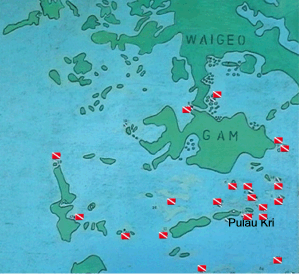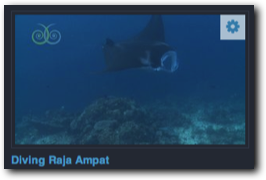New Guinea
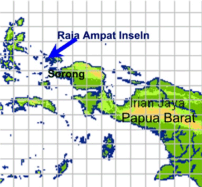
The Raja Ampat Islands
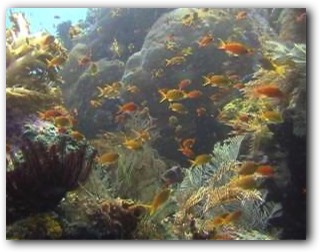
Marine biologists identified 465 different species of corals - a higher density than in Palau - and Dr. Gerald Allen, the famous ichthyologist and author of the classic "Marine Fishes of Tropical Australia and Southern Asia" documented during a single dive at Cape Kri 284 species of fish. Consequently the 2003 published Preliminary Report combining the findings of the surveys in 2001 and 2001 states that the reefs of Raja Ampat are the greatest in the world and that the region deserves the title of being the world´s richest marine biodiversity area.
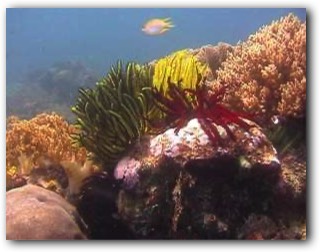
Raja Ampat (The Four Rajas) is a group of four big islands (Waigeo, Batanta, Salawati and Misool) and a large number of small and tiny pieces of sand and rocks west of Sorong. When descending on the plane towards Sorong you can see the Raja Ampats below in shades of blue, with many green, jungle covered islands and white sandy beaches.
While we landed in 2003 still on the rundown Jefman Airport with a runway dating from WW II, there is now (since 2004) a "new" airport in Sorong.
Visitors of the different dive centers are welcomed by representatives of their resort in the arrival building and then transferred by speed boats to their new home. The crossing can get unpleasant when waves are high at certain exposed stretches during the trip.
Divers with the destination Misool which is quite far away are not to be envied! Divers who join one of the many live aboard trips starting in Sorong can board their ship after a short car ride to the harbour.
Here is one of my first videos of a live aboard trip in Raja Ampat.
While we landed in 2003 still on the rundown Jefman Airport with a runway dating from WW II, there is now (since 2004) a "new" airport in Sorong.
Visitors of the different dive centers are welcomed by representatives of their resort in the arrival building and then transferred by speed boats to their new home. The crossing can get unpleasant when waves are high at certain exposed stretches during the trip.
Divers with the destination Misool which is quite far away are not to be envied! Divers who join one of the many live aboard trips starting in Sorong can board their ship after a short car ride to the harbour.
Here is one of my first videos of a live aboard trip in Raja Ampat.
Video: Mimpi Raja
Dive centers in Raja Ampat
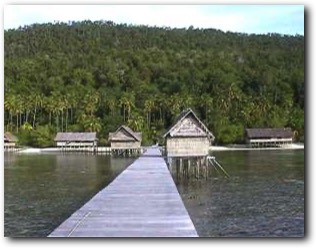
Papua-Diving
Papua-Diving is the pioneer in diving Raja Ampat. While Max Ammer, the owner, started with very basic bungalows, guests now can choose between two different resorts: Sorido Bay Resort is the new and upmarket version, Kri Eco Resort is less expensive.
Both dive resorts are situated on the little, uninhabited Island Kri. The Kri Eco Resort consists of six simple over-water Papuan-style bungalows on the beach and over the shallow water of the lagoon. The whole area is covered with coconut trees and behind the resort dense jungle starts with a lot of colourful lorries in the trees. There is a 100m long jetty leading over the reef top to the edge of the reef. The bungalows are simple and spacious. Electricity is supplied by a generator that runs through the night. So you can comfortably load your battery-packs while sleeping. The beds are protected by mosquito nets
However malaria prevention is necessary, as Papua Barat is a high-risk malaria region. Each bungalow has a huge veranda with simple bamboo benches and tables.
There are shared amenities, two western style toilets and two Indonesian style washing places. Meals are prepared and eaten in the spacious restaurant on the beach. There is plenty and tasteful food, especially when the Dutch owner, Max Ammer, is at the resort.
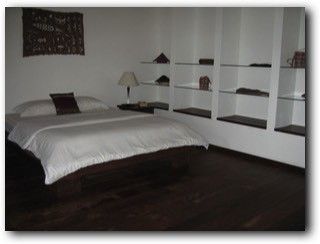
Papua Diving also closely co-operates with the indigenous people in the surrounding villages. The whole staff are locals and also the experienced dive guides are Papuans.
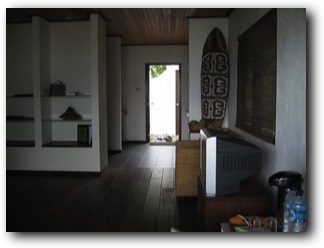
Max Ammer and more or less the whole staff are Seventh Day Adventists. That is why there is no diving between Friday night and Saturday evening at the resort. Usually Max offers an alternative Programm for Saturdays like watching birds of paradise on the island Gam on the other side of the strait.
Most dive sites can be reached in a short time (10 - 20 minutes). Dive sites further away are normally visited during whole day trips with lunch provided in between two dives. All boats have oxygen on board. The closest pressure chamber is at Manado, several hours away by plane. Tanks are always well filled and the air is clean. Compressor-filters are changed regularly.
Raja Ampat Dive Lodge
This resort opened in Oktober 2009 on the island of Mansuar which is the bigger island south west of Kri. So all the top dive sites in the Dampier Strait are easy to reach.
Similar to the expensive resorts on Kri the bungalows line up close to the small beach. There is also a long jetty which leads directly to the house reef. Guests stay in simple air conditioned double bungalows. The plan is to construct a maximum of 10 bungalows so that in the end the resort will be able to accommodate a maximum of 20 guests.
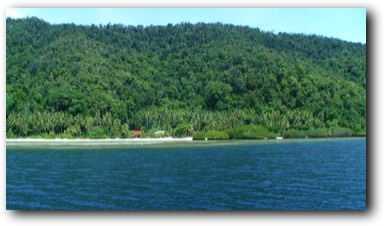
The picture on the left shows the setting of the resort on Mansuar surrounded by thick jungle.
Diving in Raja Ampat
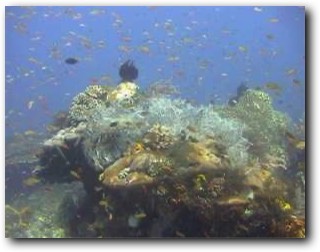
During our 8 visits of Raja Ampat since 2003 we had very different visibility under water. If you are lucky visibility reaches 20+ m but you might also dive in water with no more than 5 m visibility. Especially between Juli and August diving conditions can be bad. Most live aboards leave Raja Ampat during this time of the year and offer diving in other areas of Indonesia where conditions are better.
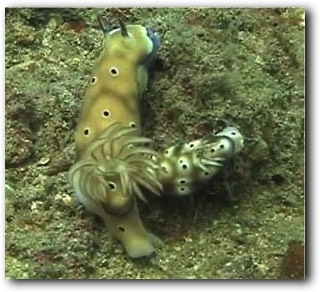
Dive sites in Dampier Strait
Cape Kri
is only 5 minutes away from the resort at the north-eastern tip of the island. There are always strong currents at this spot and the usual bunch of predators is passing by or waiting in the blue. We saw during every dive many dogtooth tunas, jacks, giant trevallies, barracudas, big napoleon wrasses and a few white tip reefsharks. There is also a good chance to spot giant groupers which meet here regularly. There are always huge schools of fish passing by. The coral formations are impressive and extremely diverse. In the shallows there are nudibranches and different kinds of scorpion fish. At the end of the dive divers must be careful not to be caught by the strong down current on the opposite side of the cape.
Sardines
became our favourite divespot. Here we found all the highlights which make diving the Raja Ampats a special experience. Giant schools of fish sometimes swim between the divers so that you will only see fish bodies for a while. Big pelagics like tunas, giant trevallies and reef sharks pass by, while huge schools of humphead parrotfish crack the hardcoral like eating potato chips. There are also some wobbegongs on or below table corals and in the huge gorgonian fans we discovered a little brown pigmy seahorse.
Chickenreef
is a big reef with several good divespots. Do not look for chickens. The divespot got its name from the nameless diver who took his knife and hid behind a coral bommy when a reef shark appeared. We would have been glad if we had seen more! Anyway, this is a good dive with lots of fish and the usual predators waiting in the current.
Mike´s Point
is a tiny limestone island in the north of Kri. The underwater landscape is very varied. During the dive you follow a wall with overhangs and beautiful gorgonian fans with pigmy seahorses. The dive ends in the shallows in a huge field of staghorn coral and nearby are colourful gorgonians in only 3 - 4m depth. In the current there are big schools of snappers. During one dive a dugong was sighted.
is only 5 minutes away from the resort at the north-eastern tip of the island. There are always strong currents at this spot and the usual bunch of predators is passing by or waiting in the blue. We saw during every dive many dogtooth tunas, jacks, giant trevallies, barracudas, big napoleon wrasses and a few white tip reefsharks. There is also a good chance to spot giant groupers which meet here regularly. There are always huge schools of fish passing by. The coral formations are impressive and extremely diverse. In the shallows there are nudibranches and different kinds of scorpion fish. At the end of the dive divers must be careful not to be caught by the strong down current on the opposite side of the cape.
Sardines
became our favourite divespot. Here we found all the highlights which make diving the Raja Ampats a special experience. Giant schools of fish sometimes swim between the divers so that you will only see fish bodies for a while. Big pelagics like tunas, giant trevallies and reef sharks pass by, while huge schools of humphead parrotfish crack the hardcoral like eating potato chips. There are also some wobbegongs on or below table corals and in the huge gorgonian fans we discovered a little brown pigmy seahorse.
Chickenreef
is a big reef with several good divespots. Do not look for chickens. The divespot got its name from the nameless diver who took his knife and hid behind a coral bommy when a reef shark appeared. We would have been glad if we had seen more! Anyway, this is a good dive with lots of fish and the usual predators waiting in the current.
Mike´s Point
is a tiny limestone island in the north of Kri. The underwater landscape is very varied. During the dive you follow a wall with overhangs and beautiful gorgonian fans with pigmy seahorses. The dive ends in the shallows in a huge field of staghorn coral and nearby are colourful gorgonians in only 3 - 4m depth. In the current there are big schools of snappers. During one dive a dugong was sighted.
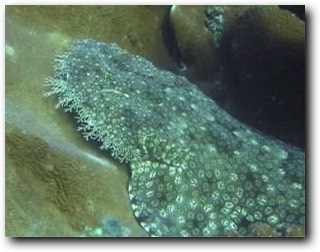
If you have never seen a wobbegong before, this is the site where you definitely will see one. There are usually several of these rather boring nocturnal sharks laying decoratively on table corals. They only move, when you really come very close. There are big schools of snappers in sheltered parts behind rocks and they let underwater photographers come very close.
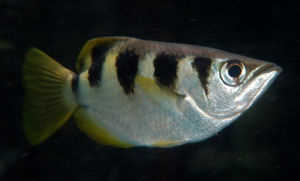
The islands Waigeo and Gam are separated by a passage through which the water rushes depending on the tides in both directions. It actually makes you feel like diving in a rapid-water river. The riverbanks are covered with dense jungle and from below you can see the foliage and the blue sky above you. Fortunately there are several bays and big boulders where the water is calm and where the bottom is covered with purple soft corals and colonies of sea squirts. At some spots orange coloured gorgonian fans nearly reach the surface. In the branches of sunken jungle trees cardinal fish swim around and just below the surface we watched archer fish looking for prey on the foliage of the trees.
Nudibranch Rock
is close to the end of the Passage. You will find more than 20 species of nudibranchs, several species of gobies, pipefish and the occasional wobbegong during a single dive.
Other dive sites:
- Fam Wall (mandarin fish, ghost pipe fish, pigmy seahorse, fire shells)
- P47 D-Bomber, Razerblade-Thunderbolt The wreck lies in 30m depth on its back. It is totally encrusted with hard- and soft coral. A dive which is not worth the effort as the reef is rather poor.
- Wai Island. In October, November there are big manta rays here.
Videos: Diving in Raja Ampat
Video: Blue Water Impressions
My collection of underwater videos from Indonesia can be found on vimeo. The collection is sorted into albums containing only videos of a specific diving area. This is a very good opportunity to have a look at videos from other divers who have been in the area before.
You can see here what other divers have seen in Raja Ampat before.
You can see here what other divers have seen in Raja Ampat before.
Video: Triton Bay
Travel Tips West Papua
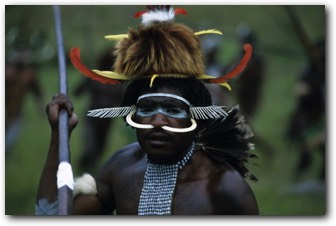
After one night in Manado you take the connecting flight to Sorong with the domestic carrier Merpati, which has a strong reputation for being the most unreliable airline of Indonesia. All other connections via Jakarta or Denpasar will even take longer as there will be an additional overnight stay.
Travellers heading for Papua Barat should always have enough extra time to catch their connecting flights in case of cancellations or delayed flights.
Papua Barat is a high risk malaria region. Malaria prevention is necessary.
Apart from these obstacles Papua Barat is a fascinating place to visit. Until now impenetrable jungle covers most of the island and there are still places which very few westerners have visited before. In remote areas really primitive tribes are living. There is however very little touristic infrastructure. It is relatively easy to go to Biak, Jayapura or the Baliem valley. As soon as you head for more remote destinations things start to become complicated. You need a lot of time, good physical condition and a lot of money to charter planes and longboats in order to reach your destination.
For travelling in Papua Barat you are obliged to get a police permit (Surat Jalan). This permit must state all the places you are heading for. Travellers must report to the local police when arriving at their destination. You need two passport photos and several photocopies of your passport to get your Surat Jalan at the police offices in Jayapura, Sorong or Biak.
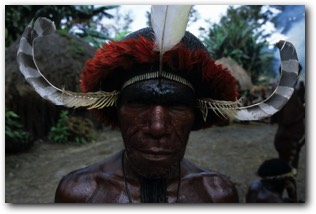
After the chairman of the West Papuan Representation, Theys Hiyo Eluay, had been killed by members of the Kopassus bataillion of the Indonesian armee in the end of 2002, riots occured in several regions of the country, especially in Biak, Sentani and Wamena in the Baliem valley. The hatred of the Papuan people against the Indonesians is evident everywhere.
While visiting the Baliem valley in August 2003 there were OPM-activities in the northern end of the valley. At the same time there was evidence that members of fundamentalist groups like Jemaah Islamiah and Laskar Jihad were infiltrating this predominantly christian area under the approving eyes of the Indonesian army. While trekking in the south of the Baliem valley we found a newly built mosque and met heavily armed fundamentalist militants from Java.
It makes sense to ask your foreign ministry for up-to-date information on the security situation in Papua before you start.
It makes sense to ask your foreign ministry for up-to-date information on the security situation in Papua before you start.

